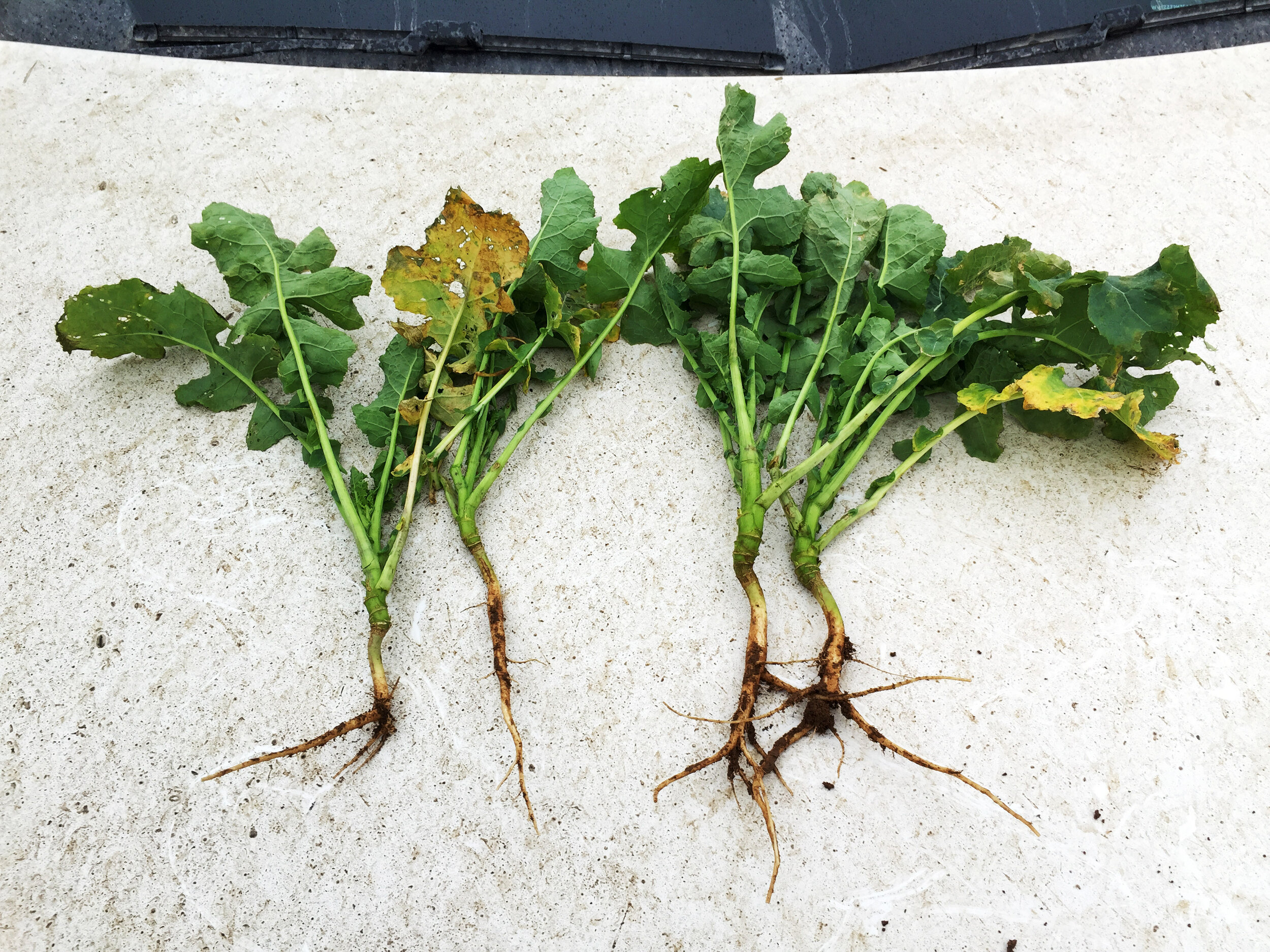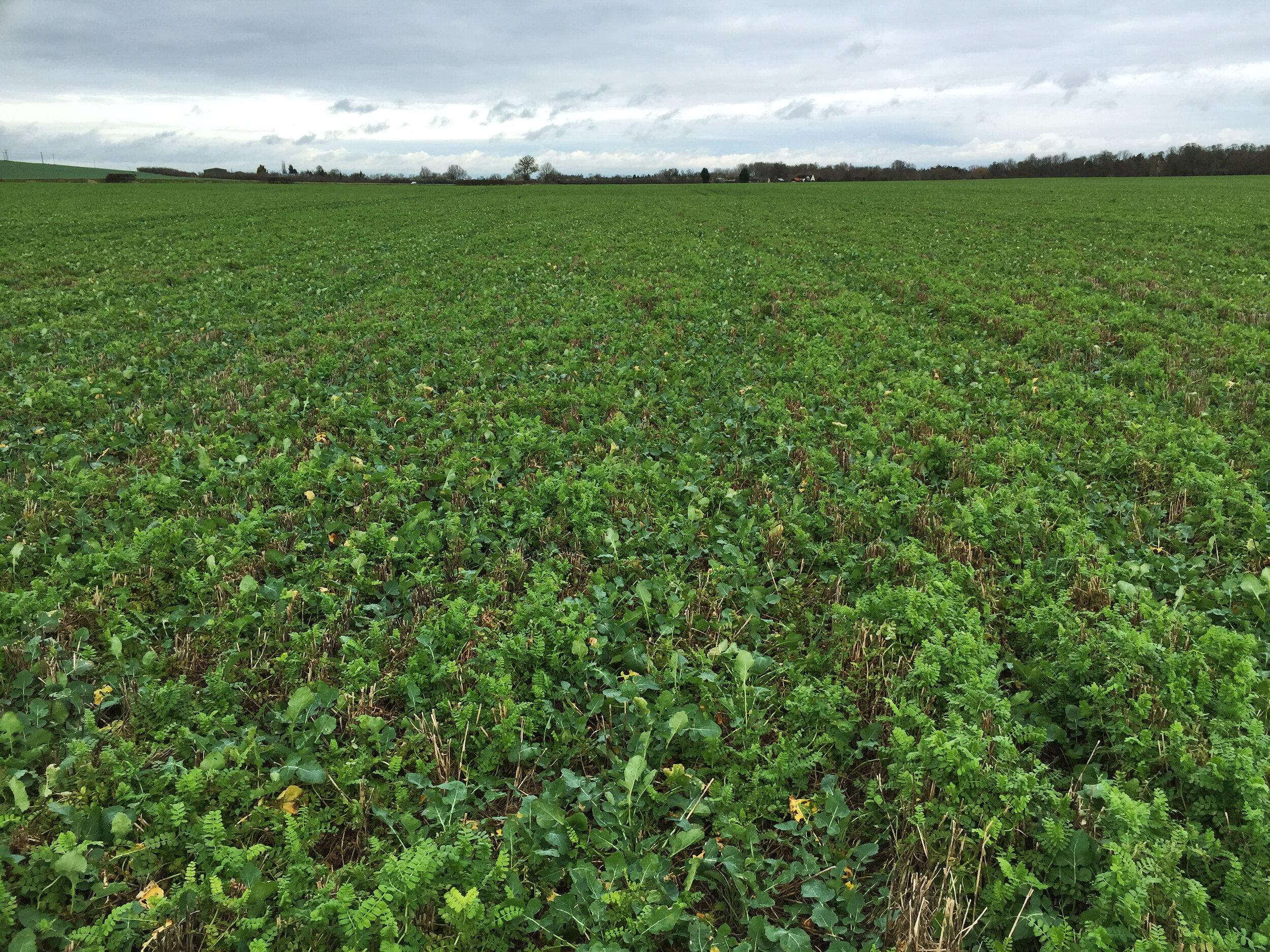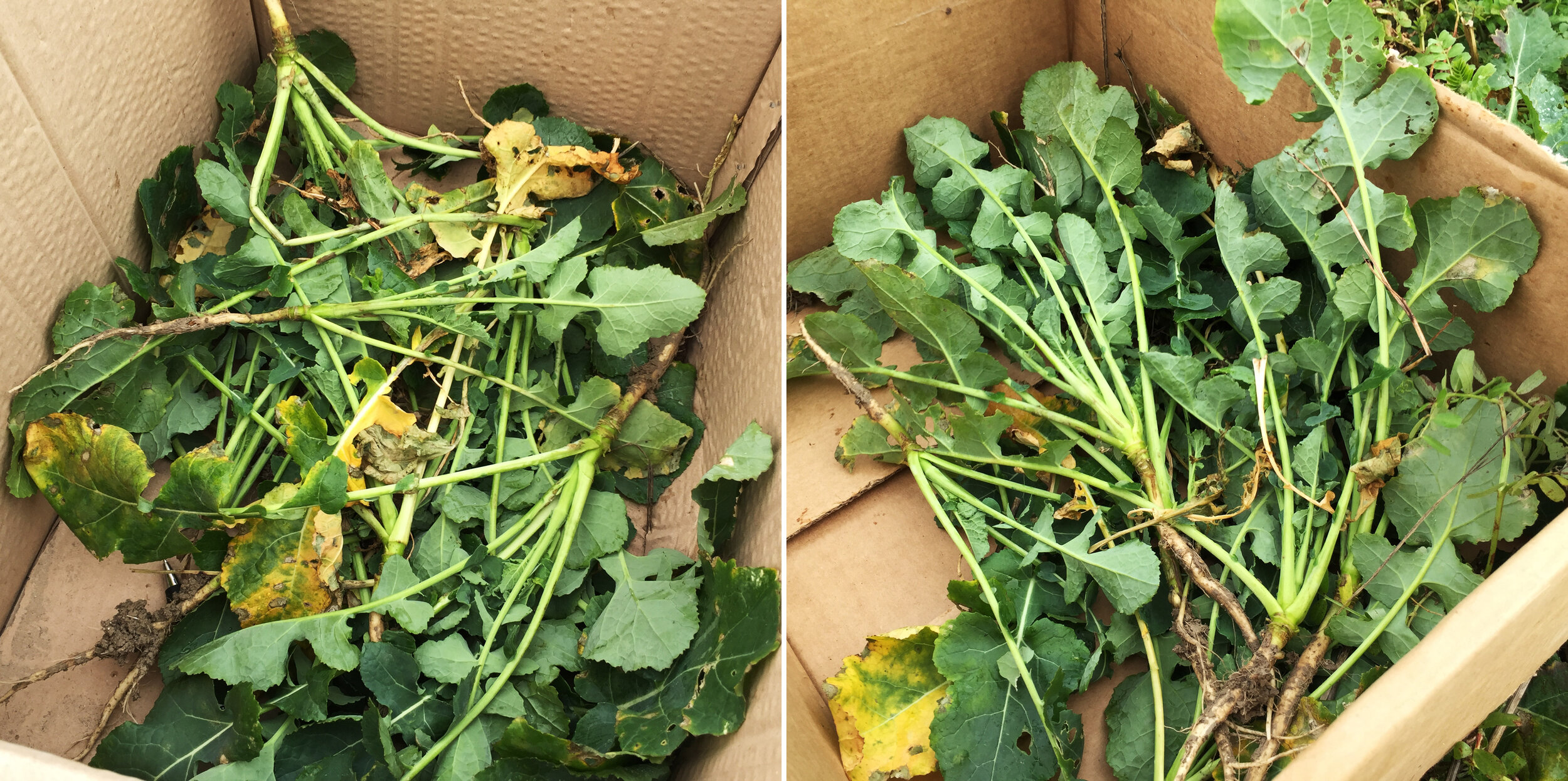Neonics, pyrethroids, rapeseed, guesses and dodgy stats
Standby for some unscientific science. Here's a story about two fields of oilseed rape on our farm.Field 1Here's the deets. 18ha field, sown with Campus OSR. Half of it was drilled with Hypro Duet seed dressing, which is a fungicide. The other half had Cruiser dressing, which is a neonicotinoid [neonic] insecticide - and it was drilled roughly a week later. As fans of Countryfile will know, neonic seed dressings are currently banned on oilseed rape...apart from some small parts of the country, one of which happens to be where we farm. Apart from the neonic dressed seeds, the field has had no other insecticides applied at all. Oh, and it had a companion crop of buckwheat, lentils & fenugreek. I went out last week to count how many flea beetle larvae there were living in the plants right now. I took 10 plants from each treatment, all samples were done within about a 30m circle. I then split open all the petioles where I could see a brown lesion, and counted the larvae. Sometimes I couldn't find one when it definitely looked as if I should have; maybe I squashed them or was just blind. But hopefully my errors were consistent.I found an average of 10.5 larvae/plant in the non-neonic area, compared to 8.6 in the treated. Experiments from AHDB showed that having 5 larvae/plant in the autumn did not have an effect on yield, but obviously both of my results are higher than that. On first glance it would appear the neonics have had a positive effect on keeping the flea beetle infestation down.
I went out last week to count how many flea beetle larvae there were living in the plants right now. I took 10 plants from each treatment, all samples were done within about a 30m circle. I then split open all the petioles where I could see a brown lesion, and counted the larvae. Sometimes I couldn't find one when it definitely looked as if I should have; maybe I squashed them or was just blind. But hopefully my errors were consistent.I found an average of 10.5 larvae/plant in the non-neonic area, compared to 8.6 in the treated. Experiments from AHDB showed that having 5 larvae/plant in the autumn did not have an effect on yield, but obviously both of my results are higher than that. On first glance it would appear the neonics have had a positive effect on keeping the flea beetle infestation down. But unfortunately it was not as simple as that. The treated area was drilled around a week later, and with a higher seedrate. This meant that the plants were significantly smaller than in the untreated bit. So I walked out again and did a plant population count - 33 vs 58 plants/m2. Multiply this number by the larvae counts, and we see that there are actually more larvae in the neonic area - 345 vs 503 larvae/m2. And finally... I counted how many petioles each plant had, and then divided the larvae count by that number. The result was almost identical 1.18 vs 1.19 larvae/petiole.So the neonic area "won" the first test, "lost" the second, and "drew" the third. What does it mean? I've no idea! As always, harvest will tell the only story that actually matters.[UPDATE: Since writing this I was worrying about a couple of possibilities, so I have investigated them further. First of all, I wondered if perhaps I had taken the samples from too close; maybe some beetles had leaked over from the non-neonic side. So to test this I went over to the other side of the field, as far away as possible, and checked again. I did not do a full "scientific" sample set, but there were no fewer larvae than the first location.Secondly I thought maybe the neonic seed treatment was irrelevant, and the higher infestation was down to just the lack of foliar sprays. Luckily I could test this too, as we have a third field that was drilled entirely with neonic seed, but had no insecticide sprays at all. Again I did an informal count and the numbers were much lower, maybe 4-5 per plant. So even with no sprays it is possible to be below the yield reduction threshold.]Field 245ha field, all drilled at the same time with Picto and a companion crop of vetch, buckwheat and lentils. The seed dressing was Hypro Duet - i.e. not an insecticide.
But unfortunately it was not as simple as that. The treated area was drilled around a week later, and with a higher seedrate. This meant that the plants were significantly smaller than in the untreated bit. So I walked out again and did a plant population count - 33 vs 58 plants/m2. Multiply this number by the larvae counts, and we see that there are actually more larvae in the neonic area - 345 vs 503 larvae/m2. And finally... I counted how many petioles each plant had, and then divided the larvae count by that number. The result was almost identical 1.18 vs 1.19 larvae/petiole.So the neonic area "won" the first test, "lost" the second, and "drew" the third. What does it mean? I've no idea! As always, harvest will tell the only story that actually matters.[UPDATE: Since writing this I was worrying about a couple of possibilities, so I have investigated them further. First of all, I wondered if perhaps I had taken the samples from too close; maybe some beetles had leaked over from the non-neonic side. So to test this I went over to the other side of the field, as far away as possible, and checked again. I did not do a full "scientific" sample set, but there were no fewer larvae than the first location.Secondly I thought maybe the neonic seed treatment was irrelevant, and the higher infestation was down to just the lack of foliar sprays. Luckily I could test this too, as we have a third field that was drilled entirely with neonic seed, but had no insecticide sprays at all. Again I did an informal count and the numbers were much lower, maybe 4-5 per plant. So even with no sprays it is possible to be below the yield reduction threshold.]Field 245ha field, all drilled at the same time with Picto and a companion crop of vetch, buckwheat and lentils. The seed dressing was Hypro Duet - i.e. not an insecticide. In September there was some flea beetle pressure, so we were given a recommendation to spray with a pyrethroid. Personally I was less than convinced, having done similar things last year - so we left 25% of the field un-sprayed. A month or so later we had another recommendation for pyrethroids again, this time for stem weevil. The whole field was treated.I took all the same measurements as in the first field. There were more larvae in the once treated area compared to the bit sprayed twice - 3.6 vs 1.5. However, both are still below the threshold of yield reduction. Plant populations were odd; 81 vs 63/m2. It didn't look different to the eye, but the stats never lie (errr...). This means we had more flea beetles in total in the once treated bit, 293 vs 94 larvae/m2. The plants were of pretty similar size, 7.6 vs 6.8 petioles/plant, which in turn means double the number of larvae/petiole in the once area.
In September there was some flea beetle pressure, so we were given a recommendation to spray with a pyrethroid. Personally I was less than convinced, having done similar things last year - so we left 25% of the field un-sprayed. A month or so later we had another recommendation for pyrethroids again, this time for stem weevil. The whole field was treated.I took all the same measurements as in the first field. There were more larvae in the once treated area compared to the bit sprayed twice - 3.6 vs 1.5. However, both are still below the threshold of yield reduction. Plant populations were odd; 81 vs 63/m2. It didn't look different to the eye, but the stats never lie (errr...). This means we had more flea beetles in total in the once treated bit, 293 vs 94 larvae/m2. The plants were of pretty similar size, 7.6 vs 6.8 petioles/plant, which in turn means double the number of larvae/petiole in the once area. I think drawing conclusions is easier here, as there's a much closer and more scientific comparison. It seems clear that the first application of pyrethroids had some effect on reducing the number of flea beetles. That shouldn't be surprising, but as the plants seem healthy and the larval numbers are below yield affecting thresholds I'm happy with the decision not to spray. In fact I only wish I had left some of that part of the field un-treated on the second application as well.I think the difference between the two fields is interesting. The neonic treated field has a much higher burden of flea beetle larvae than the untreated one, but they are a few miles apart, using different varieties and different companion crops. The only certainly at this point is that neonics are most definitely not a guaranteed way to keep flea beetle at bay. I've been saying for a while now that if we grow rapeseed next year it will not be treated with neonics, even if they are permitted. I haven't seen a reason to change that opinion yet.
I think drawing conclusions is easier here, as there's a much closer and more scientific comparison. It seems clear that the first application of pyrethroids had some effect on reducing the number of flea beetles. That shouldn't be surprising, but as the plants seem healthy and the larval numbers are below yield affecting thresholds I'm happy with the decision not to spray. In fact I only wish I had left some of that part of the field un-treated on the second application as well.I think the difference between the two fields is interesting. The neonic treated field has a much higher burden of flea beetle larvae than the untreated one, but they are a few miles apart, using different varieties and different companion crops. The only certainly at this point is that neonics are most definitely not a guaranteed way to keep flea beetle at bay. I've been saying for a while now that if we grow rapeseed next year it will not be treated with neonics, even if they are permitted. I haven't seen a reason to change that opinion yet.
